
 | The Xenophile Historian |
THE HOLY BOOK OF UNIVERSAL TRUTHS,
K. U. P.
(Kimball's Unauthorized Perversion)
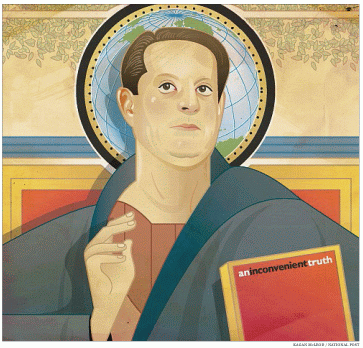
1. The idea that global warming is inevitable. If this year is warmer than average, we are told it's because of global warming. If we get snow out of place and out of season (e.g., Orlando, Florida in October 2006), our climate must be messed up from global warming. 2005 was a record year for hurricanes, and it's global warming's fault. On the other hand, after 2005 the North Atlantic went for twelve years without a major hurricane, so global warming must be responsible for that, too! A few environmentalists even tried to blame earthquakes on global warming. And then we are told we must act now to save the world, but even if we do, the glaciers will still melt and our beachfront property will end up underwater. Maybe fatalism is okay for other cultures (the Arabs sum it up with the word Inshallah--God willing), but it's not the way of Western civilization. If global warming has a solution, expect Yankee/European/Israeli/Aussie ingenuity to find it.
2. After the downfall of communism in the Soviet Union and its satellites, many communists, like Mikhail Gorbachev, became environmentalists. In other words, yesterday's Reds may be found among today's Greens. No wonder their plans for saving the earth include dismantling capitalism. If I was a member of the John Birch Society, I'd call global warming a communist plot!
Along that line, don't forget how well communism treated the environment, when the Reds ruled the Soviet Union and eastern Europe. Chernobyl. Nuclear tests that rendered large tracts of land radioactive, including a program that used nukes to drill for oil! The drying out of the Aral Sea, causing an entire ethnic group, the Karakalpaks, to suffer from toxic waste and the loss of their livelihood. Darvaza, a gas crater in Turkmenistan that was set on fire in 1971, and is still burning. Vast oil spills in Siberia. The blue Danube River turned black with untreated waste, where it went through Hungary. Outdated, dilapidated factories, smelters and mines, some of which emitted more air pollution than all of Canada. A fine track record, wouldn't you say?
3. Man-made activity is probably responsible for only 5 percent of all carbon dioxide emissions. Volcanoes, rotting vegetation, animals, and even bubbles from the ocean give us the rest. The same goes for methane, another warming gas; termites alone produce more methane than we do. What are we supposed to do about all that? Put a filter on Mt. St. Helens, like the "scrubbers" used in the smokestacks of modern factories and power plants?
4. The polar icecaps on Mars are melting, too. Dang those SUV-driving Martians! And in May of 2007 it was announced that even Neptune, our outermost planet, has been getting warmer since 1980. Finally, some scientists at the Danish National Space Center have suggested that global warming is caused not by man, but by cosmic rays from exploded stars (The Chilling Stars: A New Theory on Climate Change, by Nigel Calder and Henrik Svensmark, copyright 2007).
5. The sun fluctuates in brightness. Maybe this is not as obvious as a campfire flaring up or dying down, but it changes nonetheless. Right now it's burning hotter than it did two thousand years ago. From 1975 to 2007, the sun experienced more sunspots than usual, and meteorologists tell us that that affected our weather, too. So why are so few people blaming the sun for global warming?
6. The hottest year on record, since weathermen started measuring daily temperatures, was 1934. In the lifetime of most of us, the hottest year was 1998. It was in that summer when I joked about taking a vacation in Libya, to get away from my drought and wildfire-ravaged home state. If the earth is really getting hotter, why hasn't our weather matched or beaten the 1998 records yet? This has caused an Australian climate scientist, Bob Carter, to exclaim that "There is a problem with global warming . . . it stopped in 1998."
7. The graphs showing CO2 levels gradually rising are simply false. Actual levels are shown in the graph below, and from that you can see we had the most carbon dioxide in our atmosphere in 1943. I suppose we can blame that on World War II; no doubt those burning tanks at the battle of Kursk caused a lot of pollution.
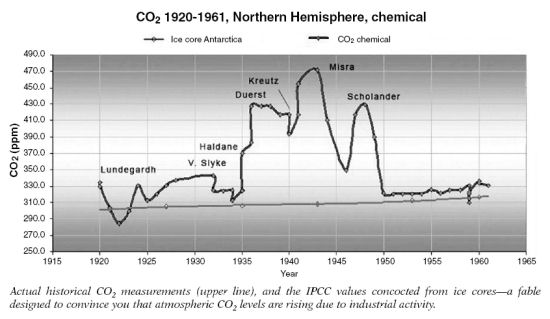
9. How much of a role does the ocean play in climate change? Before the launching of weather satellites, we knew almost nothing about weather patterns over the ocean, and today we still don't collect data as throughly and consistently as we do on land. To give an extreme example, the weather station on St. Helena Island provides nearly all available meteorological data for a third of the Atlantic. Would our predictions of climate change be different, if we had reliable temperature, wind and rainfall measurements for the open sea?
10. Can we even trust our own weathermen? Most of the time, they can't accurately predict if we'll get rain a week from next Tuesday. NASA is now admitting that the temperature data it collected in 1999 and 2000 was probably incorrect, due to a Y2K bug. In October 2008 there were reports around the world of unexpected snow and low temperatures (Tibet reported the "worst snowstorm ever"), but because NASA's Goddard Institute for Space Studies had mistakenly included September data for Russia, it reported the hottest October on record. And Anthony Watts, a California weatherman, has a blog called "Watts Up With That?", which shows that a disturbing number of weather stations don't measure temperatures properly. Many of them place thermometers near man-made objects that are likely to cause above-average temperature readings, like air conditioner fans, asphalt parking lots, and the ends of airport runways. Weather stations in towns with a population of only 300 have shown a difference in temperatures, compared with weather stations in the surrounding countryside. So how many of our measurements point to urban warming, rather than global warming?
11. Meanwhile, south of the equator, thermometer readings over the past century suggest that average temperatures are going down. This may be because most of the earth's land is north of the equator. Which hemisphere is right? Again, it looks like the alarmists are paying too much attention to weather in their own neighborhoods.
12. Today I have to go to states in the Deep South (e.g., Florida, Georgia, Alabama and Mississippi) at the end of summer to find muscadines (also called scuppernongs), my favorite kind of grapes. However, recently I learned that Civil War diaries mention muscadines growing wild in Kentucky, where I now live. Did the Bluegrass State have a warmer climate in the mid-nineteenth century?

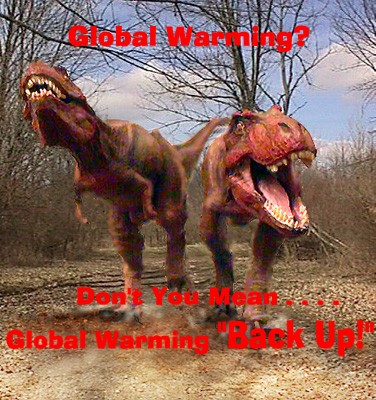
15. The most recent warm time mentioned in point #13 above is the "Medieval Warming Period," which lasted from 800 to 1200 A.D. It helped end the Dark Ages, and allowed the Vikings to raid and conquer much of the world beyond Scandinavia. It also made Greenland just "green" enough for some Vikings to colonize it. Note that the Greenland colonies failed when the "Little Ice Age" arrived (1300-1700), leaving all of that huge island to the Eskimos. And in 2005, a medieval silver mine was discovered in Europe (I didn't hear exactly where, so I'm guessing it's in the Alps), when the glacier on top of it melted. The mining tools were carefully arranged inside, leading us to believe that the miners went home for the winter, expecting to come back and do some more digging next year. I can just imagine Big Ulrich telling the other miners on the last day, "This is my pick, don't none of you forget it!" Instead, the ice and snow covering the mine didn't melt when spring arrived, forcing the miners to seek new jobs. Does this mean that for the past 700+ years, Europe's climate was colder than it should be?
If your answer to the above question is "yes," then recent warming may be nothing more than a recovery from the Little Ice Age. This is why one scientist who blames global warming on humans has reportedly said, "We have to get rid of the Medieval Warming Period." Indeed, Michael Mann, the inventor of the hockey stick graph, refuses to believe that the Medieval Warming Period and the Little Ice Age were worldwide events.

17. CO2 is not a pollutant, but an essential plant food. You put a little more carbon dioxide into the atmosphere, and it will make it easier for crops and rainforests to grow. Anything wrong with that?
18. The ice-core samples mentioned in #13 above also preserve a record of carbon dioxide levels in ancient times. They show that the percentage of atmospheric CO2 has gone up and down in the past, but the CO2 increases happened as late as 800 years after temperature increases. Thus, one could argue that rising temperatures cause rising CO2 levels, instead of the opposite.
19. Global warming made headlines in 2007 when the United Nations got on the bandwagon, by issuing a 21-page report from a group called the Intergovernmental Panel on Climate Change (IPCC). Like the environmentalists, this report predicted that disaster was about to happen, and that it would go on for centuries, no matter what we do. Well, all we have to do is remember the messenger. The UN is a corrupt, anti-American, anti-Semitic, anti-capitalist, dictator-loving organization. It never does a very good job of solving problems, whether it is preventing wars, or helping the victims of disasters like the 2004 tsunami. What is does best is provide job security for those who want to talk about such problems indefinitely.
20. The infamous Kyoto Accords were designed specifically to cut down the economies of powerful capitalist countries, especially the United States, but they exempt two of the world's biggest polluters, China and India. All of the world's ten filthiest cities, in fact, are in China and India. In Beijing, for example, smog levels are high enough to blot out the sun, and the smog will make you think a volcano erupted nearby. When the Kyoto Accords came up for a vote in Congress in 1999, the Senate unanimously voted no. If they had voted yes, the result would have cost us $300 billion annually, destroyed more than 2 million jobs, and reduced America's gross domestic product by three percent. Even the White House, which then had a Democrat as president, refused to consider the Accords. Al Gore was there, too; did he agree with the Senate vote at the time? The nations that approved them saw their economies stagnate.
21. A cutback in energy usage and overall consumption, as the Kyoto Accords mandate, is likely to hurt developing countries the most. Unlike the most advanced nations, they can't afford to try "green" alternatives, and if they can't have economic growth, the only alternative is miserable poverty. That is why Vaclav Klaus, the Czech president, recently called global warming a scam.
22. David Evans, another Australian scientist (see #6 above), was in charge of looking for carbon emissions, to make sure his country complied with the Kyoto Accords. He has become a skeptic because he didn't find any place where carbon emissions were concentrated; no CO2 signature, no smoking hot spot.
23. Except for the Unabomber, I don't see too many environmentalists willing to set an example by cutting back on their consumption. Arianna Huffington, for example, makes waves by driving to and from "Save the Earth" rallies in an SUV. Nor is there a call for us to imitate the Amish, who already have a lifestyle that minimizes their impact on the environment. Every year during his presidency, Barack Obama used multiple planes to fly his family and staff to Hawaii for Christmas vacation, instead of taking a shorter, less-polluting trip to a vacation spot on the mainland, like all his predecessors did. Secretary of State John Kerry warned that air conditioners and refrigerators are as big a threat to life as terrorism, but he did not follow up on his statement by removing air conditioners from the offices of the State Department. And if the United States is so bad for the planet, why don't we see an exodus of concerned people from there to environmentally-friendly countries like Somalia and Myanmar, where plumbing and electricity are non-existent in many areas? Where the environmentalists are consistent is in the way they have controlled their own population growth (see The Liberal Birth Dearth). Maybe their "carbon footprint" is as big as ever, but they're not leaving many descendants who are likely to do the same.
24. Speaking of not practicing what one preaches, the high priest of global warming, Al Gore, is the worst offender. The inconvenient truth about the former vice president is that "the only place Al Gore conserves energy these days is on the treadmill," as Ann Coulter wickedly put it. Not only does he fly around constantly in a private jet, pumping more CO2 into the atmosphere in a day than most of us will produce in a year, but his mansion in Tennessee consumes twenty times as much electricity as a typical house for that state. When asked to explain his consumption, Gore told us it's okay, he paid someone else to consume less, by purchasing "carbon offsets." To me it sounds a lot like a money-making racket the Catholic Church had at the end of the Middle Ages--the sale of indulgences, what we might call "sin offsets." What amazes me is that it took the Church at least a thousand years to think of this hypocritical practice, and now the environmentalists have done it in only twenty years.
25. Who's getting paid to consume less energy, anyway? Have you ever met anyone earning an income from carbon offsets? Where is that money going? This could be a good income, if you don't mind living without modern conveniences like electricity. Would the recipients live any differently, if they weren't getting paid? I get the impression that it's like paying somebody to go to the bathroom.
26. While Gore warns us that global warming will cause sea levels to rise 240 inches, and his movie shows animations of places like Florida and Shanghai getting flooded, the Intergovernmental Panel on Climate Change predicts a maximum rise of 23 inches. Meanwhile, Geologist Don Easterbrook says there have been temperature shifts up to "20 times greater than the warming in the past century." And Nils-Axel Mörner, a Swedish specialist in sea-level changes, thinks the oceans are not rising at all; he pointed out that sea levels dropped 20 cm (almost 8 inches) in the 1970s, and that during the last 2,000 years, the highest they rose above present-day levels was 1.2 meters (about 4 feet). Who's right?
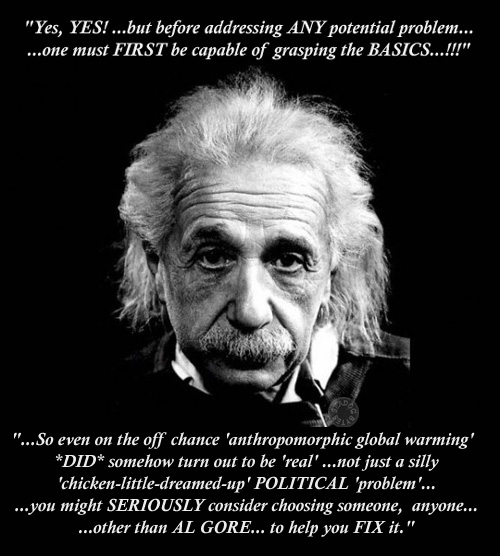
28. In January 2013, Al Gore sold his failed cable TV network, Current TV, to the Arab network Al Jazeera. What a sellout; immediately afterwards, Al Jazeera announced it would dump the old Current TV programming, and replace it with theirs. The last time I checked, the Arabs got their power from big oil, not solar or wind-generated energy. And I'm sure his followers are offended; a lot of people don't like seeing prophets make that kind of a profit. Evidently he likes the color green, not because it represents the environment, but because it also represents Islam and money.
29. If rising sea levels are going to flood our coasts, why is beachfront property still desirable? Especially in California and Florida; every time a hurricane or mudslide erodes part of the beach and destroys houses, people come back and rebuild. You've heard of people voting with their wallets; wouldn't real estate prices on all beaches drop like a rock, if the owners thought their property would be under water before they paid off the mortgage on it?
30. There are scientists with a vested interested in promoting global warming (see the next point). They are living on grant money, and if they stop preaching global warming, or announce that they have found a cure for it, that money will dry up. Look at it this way: if somebody paid you $100,000 a year to solve global warming, would you solve it very quickly? You could compare it to civil rights, where we haven't seen much progress in decades. If anyone ever declared that all the problems related to civil rights had been fixed, race warlords like Al Sharpton and Jesse Jackson would have to get real jobs, for a change.
31. The idea that man-made carbon dioxide might be warming the atmosphere was first thought up by Roger Revelle (1909-91), an oceanographer and director of the Scripps Institute in the late 1940s and 50s. Always looking for ways to increase navy and government-sponsored funding for the institute, Revelle teamed up with Hans Suess, a chemist who was interested in finding out how much carbon in the environment was produced by the burning of fossil fuels. Together they wrote a paper which suggested that man-made CO2 could result in a greenhouse effect. Then he hired a geochemist named David Keeling to measure the amount of CO2 in the atmosphere, and wrote in a 1960 paper that the amount had increased since man learned how to use coal and oil. Hence the "hockey stick" graph mentioned in #13 above.
That was how the global warming movement got started. From 1963 to 1974 Revelle was a professor at Harvard, where Al Gore was one of his students. While he was there, he also inspired the United Nations to found the IPCC (see #19) to keep an eye on the environment. However, he had a change of heart after he retired, and toward the end of his life he argued that it had not yet been proven that carbon dioxide is a problem, so we should not act too quickly on curbing CO2 emissions, until we know for sure. Apparently this recantation from the grandfather of global warming hasn't gotten much attention, because it's harder to make drastic changes when there is no crisis.
32. The ice caps in Greenland and western Antarctica are getting thicker. Why is that, if temperatures are rising?

34. Don't worry about the polar bears. Environmentalists like to illustrate the danger of global warming by showing pictures of polar bears stranded on melting ice. This was enough to get the Environmental Protection Agency to put polar bears back on the endangered species list. By doing that, they ignored three facts. First, the estimated population of polar bears has tripled since the 1970s, when they really were an endangered species. Second, they can swim for up to hundreds of miles in cold water, so even if the ice melts, they'll be all right. That's how they managed to travel to every part of the Arctic. Third, they survived previous warm periods, didn't they?
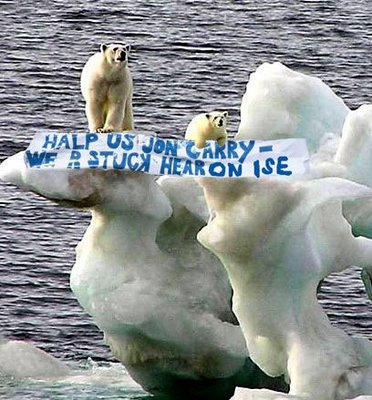
"As they review the bizarre and unpredictable weather pattern of the past several years, a growing number of scientists are beginning to suspect that many seemingly contradictory meteorological fluctuations are actually part of a global climatic upheaval. However widely the weather varies from place to place and time to time, when meteorologists take an average of temperatures around the globe they find that the atmosphere has been growing gradually cooler for the past three decades. The trend shows no indication of reversing. Climatological Cassandras are becoming increasingly apprehensive, for the weather aberrations they are studying may be the harbinger of another ice age."
There wasn't as much concern over global cooling back then, because if another ice age was on the way, it wasn't likely to cause much of a change in our lifetimes. And it's harder to blame falling temperatures on what man is doing.
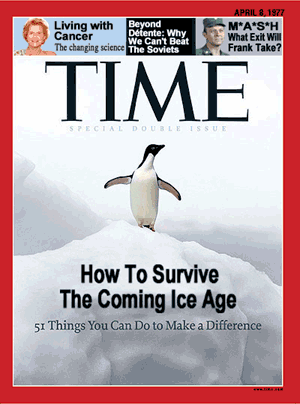

38. Most of the people I know who have faith in man-made global warming are atheists, or at least claim no religious affiliation. This reminds me of the saying "A person who believes in nothing will fall for anything."
39. A California hotel, the Gaia Napa Valley Hotel & Spa, puts a copy of Al Gore's An Inconvenient Truth in every room, instead of the traditional Gideon Bible. I guess we should have expected somebody in California to pull a trick like this. Anybody remember the bookstore in Berkeley that classified The Memoirs of Richard M. Nixon as "pornography" and kept copies of it behind the cash register, wrapped in brown paper?
40. In 2009, a British court ruled that global warming CAN be a religion for some people. I guess that settles it.
41. A reporter from National Public Radio refused to interview David Deming, an associate professor at the University of Oklahoma studying global warming, after his testimony to the Senate Environment and Public Works Committee, unless Deming would say that global warming was caused by man. And when Dr. Timothy Ball, a climatologist, did a documentary in the United Kingdom called "The Great Global Warming Swindle," he received hate mail with threatening messages like, "If you continue to speak out, you won't live to see further global warming." When was the last time you heard a scientist say something like that, to a colleague he disagreed with? You won't even hear it much among today's religious leaders, except when Moslem clergymen are denouncing everybody else (see A Call for an Islamic Reformation).

43. Have you noticed how many global warming conferences get cancelled because of too much snow? Elsewhere I have pointed out how Al Gore makes his speeches about global warming on the coldest days in January and February, in a balmy location like upstate New York. For 2009, he did it while my part of the country was experiencing the worst ice storm in its history. It happens often enough that the Urban Dictionary calls it the "Gore Effect." A recent example was at Cancun, Mexico, in December 2010. You would think a conference held in that tropical resort would be safe from winter, but while the delegates were there, the local temperature dropped to 54 degrees F., the coldest Cancun has seen in a century. I have long felt that God has a sense of humor, and it looks like the Lord is having a little fun with those folks who put more faith in Gaia, the "Earth Mother," than in Him (see points #36 through #40 above).
44. Speaking of Gaia, get a load of this quote from Al Gore's book, Earth in the Balance. Quote:
"Our religious heritage is based on a single earth goddess (Mother Gaia) who is assumed to be the fountain of all life. . . All men have a god within. Each man has a god within because creation is god. Nature in its fullness is god."
Unquote: Gore may have been a Baptist once, but these days he is more like a modern-day Druid.
45. All our models on global warming depend on how many people will be living on earth at a future date. Most assume that population will continue to grow at a geometric rate, as Thomas Malthus predicted. However, in much of the world, population growth is slowing; in Europe, Russia and Japan, population is actually shrinking. The only advanced countries that are still growing are the United States, Canada, Israel, Australia and New Zealand. Even India and China, the two countries that have had the highest populations for more than two thousand years, are expected to stop growing soon, because of female infanticide and the Chinese policy of one child per family. The latest predictions have world population rising to 7.5 or 8 billion, before leveling off and beginning a long decline. Fewer people means there's going to be less demand for fossil fuel, and less man-made pollution going into the atmosphere. Has Al Gore factored that into his alarmist predictions? Probably not.
46. In England they use a supercomputer to predict the weather. It has 15 million megabytes of memory (I assume they mean RAM and not storage space), and can do a trillion calculations every second, meaning it has the equivalent of a 1,000 GHz (or 1 million MHz) microprocessor chip. No doubt this is the kind of computer in bad science fiction stories that causes mad scientists to exclaim, "Yes. Now there is a God!" However, like Al Gore in the United States, it is one of the country's worst polluters, requiring more electricity to run than a thousand homes, and generating this much energy produces more than 12,000 tons of carbon dioxide a year. And what does the computer give in return? Well, it makes the same kind of mistakes as mortal meteorologists (see point #10 above). The worst mistake was in April 2009, when it predicted a "BBQ summer," meaning it would be very hot and dry, when nothing of the sort happened. As with the other examples in this article, you must have an awful lot of faith, more than many people have in God, to trust the computer after that whopper. Read all about it in the link below:
Weather supercomputer used to predict climate change is one of Britain's worst polluters
47. At a climate change conference in 2009, Dr. Steven Chu, President Obama's Secretary of Energy, proposed cooling the earth by painting all our rooftops and sidewalks white. By giving all our cities and towns the same sort of whitewashing treatment used in Greece, Chu argued, we could reduce pollution by the same amount as we would by taking all cars off the road for eleven years. Give me a break. I have heard scientists and science fiction writers talk about albedo terraforming, where the temperature of a planet is raised or lowered by changing the color of its landscape, but a proposal like Chu's couldn't have been what they meant. In a best case scenario, it will solve the urban warming problem (see #10 above); if the sun becomes unstable (see #5), it won't help us a bit. What other ideas does Dr. Chu have? Does he want to mine the moon for green cheese, perhaps? Or like the ancient Manicheans, try to get light from cucumbers?
48. Back in 2005, 68 percent of the lumber harvested around the world went into making paper. By 2012, that portion had dropped to less than 30 percent. Why? Because we don't need as much paper as we did just a few years ago. Instead of reading newspapers, magazines and books, a lot of people now get their information and entertainment electronically, thanks to websites, blogs, and tablets (e.g., Kindles, Nooks and iPads). And you're probably getting less mail in your real-world mailbox, now that advertisements come in your e-mail and you can pay your bills online. Thus, the trees that would have been used for all that printed matter have been spared from the chainsaw. Now those trees are doing their part to remove carbon dioxide; the reduced demand for paper also means that paper factories are spewing less CO2 and methane into the atmosphere. Of course the printed media industry is suffering in these lean times, with many publications closing altogether. Because many of the people employed by the media are true believers in global warming (e.g., National Geographic has to mention it in every issue), they ought to take comfort in knowing that their sacrifice has slowed the rate of warming, or even reversed it. If I live to see a new ice age, I will thank them for it!
49. While ice in the Arctic may be melting, ice in the Antarctic is growing (see point #11 above). In December 2013 an Australian professor, Chris Turney, sent the Australasian Antarctic Expedition, to measure the effects of climate change on Antarctica, and retrace the steps of Douglas Mawson, an Australian who explored Antarctica a century earlier. With December marking the beginning of summer in the southern hemisphere, you wouldn't expect anything to go wrong, but two weeks into the five-week mission, the expedition's ship, the MV Akademik Shokalskiy, got stuck in ice. Even more embarrassing, the ice was thick enough to defeat the first icebreaker that came to the rescue, and trap the second. They ended up using a helicopter to remove the passengers, and the ships managed to break free a week later. In one of its statements, the expedition admitted that "We’re stuck in our own experiment." Because of incidents like this, global warming believers keep their faith by talking about "climate change," rather than "global warming," though they have yet to develop a climate model that explains how man-made activity can cause ice to melt in one place and grow in another.
There, forty-nine reasons, and I didn't even get to Climategate. If you want more, this British article has one hundred. But that's too many to remember, so the five most important points are these:
I will finish by sharing my favorite cartoon on the subject. The scene below takes place a few hundred years from now, at the Suwannee Glacier.
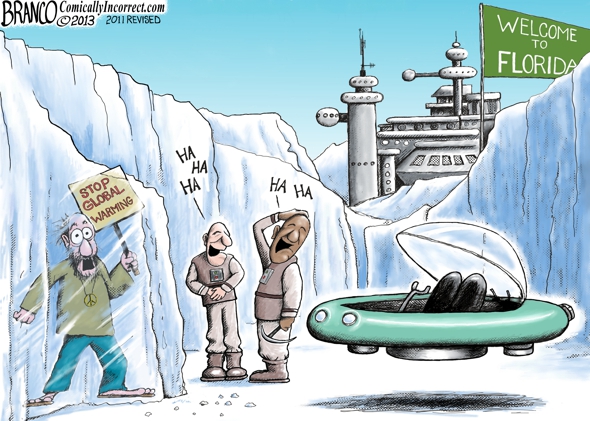
Support this site!